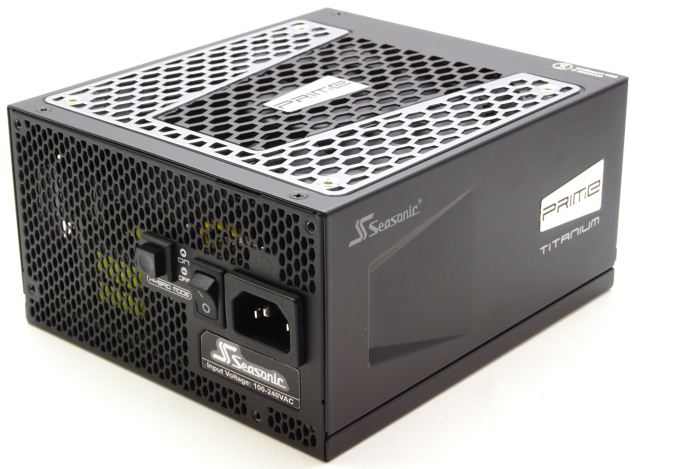The Seasonic PRIME Titanium PSU (650W, 750W, 850W) Review: Mythical Performance
by E. Fylladitakis on April 7, 2017 9:00 AM ESTConclusion
In this review we had a look at Seasonic’s latest top series, the PRIME Titanium 650W, 750W and 850W PSUs. They are not the most powerful models on the market designed for quad-GPU beats, but they are the technologically best units that Seasonic is currently offering to consumers.
It is slightly ironic to label these units as Seasonic’s “technological pinnacle”, because they are not using any of the latest “leading” topologies or technologies. As a matter of fact, their core topology is relatively common and simple; just a typical input bridge converter and APFC circuit, a resonant LLC full bridge on the primary with synchronous rectification on the secondary. It is a configuration that we have seen many times in the past, yet no other designer before Seasonic has ever reached such performance figures with it.
Seasonic made it easy for us to summarize the entirety of these units’ performance in just one word: mythical. The very high efficiency that easily broke the 80Plus Titanium certification requirements with 230V AC input was a small surprise at first, but surprise turned to shock when we began testing the units inside our hotbox. Not only the high ambient temperatures hardly shook the efficiency of the units, the power quality and voltage regulation figures were just incredible.

The AnandTech Recommended Award
For the Seasonic PRIME Titanium Series
Before testing these three units, we would not believe that such performance would be possible with a consumer-grade PC PSU.
In terms of quality, Seasonic did not hold back at all. We found only top-tier quality components in the PRIME Titanium PSUs, even down to the least significant elements of the design. The fact that the three units that we have tested display almost indistinguishable performance under the same load conditions suggests that there are no discrepancies due to component characteristics. Seasonic covers the PRIME Titanium units with a 12-year warranty, which is more than reassuring. The only small issue here is that the designer had to sacrifice some acoustics performance to ensure that the internal temperatures of the units will remain very low, even under very adverse operating conditions.
So perhaps the only real enemy of the new Seasonic PRIME Titanium series is their own retail price tag. Seasonic aims to be the best vendor with their OEM designs, and it all comes at a cost. With the 650W, 750W and 850W units retailing for $160, $175 and $200 respectively, many regular users will be satisfied with the performance of an “average” 80Plus Gold certified unit that will cost half as much, or even less. With all that being said, the retail price of these three units is not forbiddingly high - super high end PSUs reaching 1200W and above can come in at similar W/$.
But for these price tags, you get one of the most stunning PSU designs available today, combined with high efficiencies and a long warranty to back it up.












86 Comments
View All Comments
blahsaysblah - Saturday, April 8, 2017 - link
Your math??Platinum only has guarantee for 20% and above, for a 850W PS at 20% load that is 170 Watts. Platinum guarantees 90% efficiency at 20% load so 170Watt load from PC would draw 189W at wall.
Titanium adds a 10% load guarantee threshold of 90% efficiency, so a 850W PS need a 85W(95W at wall) load to 170W(185W at wall, titanium gives 92% at 20%) load.
Exodite - Friday, April 7, 2017 - link
Any word on the pricing of the fanless 600W unit?I've been using a 400W fanless gold unit for quite some time and while I expect it to last many years still it's nice to have options.
It's unfortunate, if understandable, that the high-end supplies come with such high wattages as efficiency suffers under low load scenarios.
oranos - Friday, April 7, 2017 - link
seasonic #1jabber - Friday, April 7, 2017 - link
Isn't it time we moved to some newer and more compact power connectors for motherboards? The current selection are very 1980's.JasperJanssen - Saturday, April 8, 2017 - link
No, it really isn't time to move to more compact connectors. For the amount of power you need to transfer, it doesn't really get much more compact.Byte - Sunday, April 9, 2017 - link
That's what iMacs are for.lordken - Saturday, April 8, 2017 - link
you aren't really a tech guy are you?Don't fix whats not broken. Why change power connectors as they fulfill their purpose just good? What would be benefit of such more compact redesign? That they look better? lol give me a break
And if it is disgrace for your sight to look at them, you only need to do it once when you build PC. Hope you can manage.
Go and buy yourself new phone or fancy toy to satisfy your thirst for modernity...geez
surt - Sunday, April 9, 2017 - link
There are also those niggly laws of physics to deal with.robotmaster0 - Sunday, April 9, 2017 - link
Funny you would say that since the 80's mainboard connectors (AT - 2x6pin Molex) were smaller then our big modern ones (ATX). Of course I would not want to be constrained to AT power requirements.jpak725 - Saturday, April 8, 2017 - link
if only seasonic made sfx psus of this quality